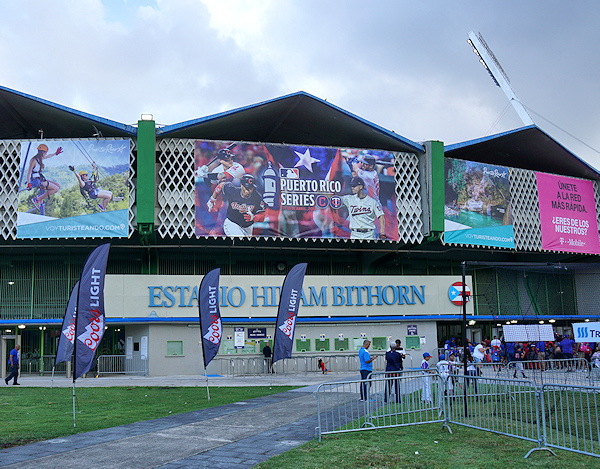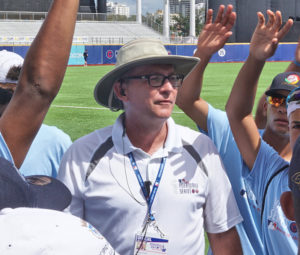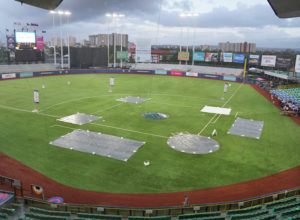by Joe Mock
All rights reserved
SAN JUAN, PUERTO RICO Late on September 6, 2017, the center of a category 5 hurricane named Irma passed within 60 miles of the northern shore of Puerto Rico. For only the second time in recorded history, a storm maintained category 5 strength for 60 consecutive hours. Damage in Puerto Rico was catastrophic, and three lost their lives. Over a million residents of the island had no electricity.
 While the island was still reeling from Irma, Hurricane Maria arrived on September 20. Its strength was on the border between Category 4 and 5. The sustained winds of 155 MPH and torrential downpours destroyed what was left of the electrical grid, leaving the entire island without power. The confirmed death toll in Puerto Rico was 64 and damage was estimated at a staggering $115 billion.
While the island was still reeling from Irma, Hurricane Maria arrived on September 20. Its strength was on the border between Category 4 and 5. The sustained winds of 155 MPH and torrential downpours destroyed what was left of the electrical grid, leaving the entire island without power. The confirmed death toll in Puerto Rico was 64 and damage was estimated at a staggering $115 billion.
Three months later, 45% of the island’s residents still lacked power. Over 300,000 lacked tapwater. As San Juan Mayor Carmen Yulin Cruz put it, “It was a one-two punch. The first hurricane left us loopy and the second knocked us down completely. It was certainly a humanitarian crisis.”
This is what Murray Cook encountered when he visited San Juan on December 1. He is Major League Baseball’s longtime consultant on playing fields. He gets them ready for the World Baseball Classic, MLB exhibitions outside the U.S., and places where MLB simply wants to bring the game of baseball. Examples are Fort Bragg, NC in 2016 and Williamsport, PA last year during the Little League World Series.
Cook had come to the island less than three months after the hurricanes to assess the damage to Hiram Bithorn Stadium, and to see whether San Juan’s infrastructure could handle the return of Major League Baseball as scheduled in April of 2018.
He’d helped prepare this ballpark for almost four dozen games over the past two decades — everything from the opening of the Big League season in 2001 to scheduled “home” games for the Expos in 2003 and 2004 to numerous WBC and regular-season games.
“In coming from the airport to the ballpark, you saw a lot of debris all around,” he recalled of that visit in December. “Hotels hadn’t re-opened. Only some of the streetlights were working. They were still in full recovery then.”
Indeed, Roberto Clemente Coliseum next door to the ballpark was the FEMA staging area, and hundreds of repair vehicles were coming and going at all hours of the day and night. “It was tough even getting into the stadium,” he said.
But he wasn’t prepared for what he found within Hiram Bithorn. “The batting tunnels were totally demolished. The lighting system was shredded. Basically all 500 (light) fixtures were broken. Some were laying in the field, some dangling from the poles. Pieces of the video board were scattered around. Debris was all over the field. All of the ceiling tiles and air-conditioning venting in the pressbox had been blown out.
“That gave us a lot of work to do.”
But who would do the work? Cook serves as the president of BrightView Sports Turf Services, and the company had 100 employees already on the payroll at their Puerto Rico offices. As recently as January, only 30 of them had power at home. But that didn’t stop them from coming to work.
“Your heart goes out to these people here,” Cook revealed. “They’ve suffered so much. I mean, the infrastructure here was never the best. And when you get massive storms like they had, it’s ten times worse.”
 Adding even more pressure to the timeline was something that couldn’t wait. “They wanted to play the Winter League here and they were willing to play a shortened season, but they’d had Winter League for many, many years, so they still wanted to play it.” He explained that only two ballparks on the island had survived the storm in such a way that they could be made ready for games. The four teams in Puerto Rico had agreed to share those two facilities – and Hiram Bithorn was one of them.
Adding even more pressure to the timeline was something that couldn’t wait. “They wanted to play the Winter League here and they were willing to play a shortened season, but they’d had Winter League for many, many years, so they still wanted to play it.” He explained that only two ballparks on the island had survived the storm in such a way that they could be made ready for games. The four teams in Puerto Rico had agreed to share those two facilities – and Hiram Bithorn was one of them.
Two amazing things then occurred. First, Cook (shown in the photo with his amateur groundscrew on April 17) and his staff repaired the artificial playing surface at Hiram Bithorn sufficiently so that Winter League games could be played. Second, at the end of the winter season, the team representing Puerto Rico not only competed in the Caribbean World Series in Guadalajara, Mexico, they won it.
“When Puerto Rico won the Caribbean World Series, it was a very, very important thing for the people here,” noted Carlos Marin, the Administrator of Bithorn Stadium. “We have a real passion for the sport.”
By no means was the work on the ballpark finished, though. To prepare for the MLB games in April, Cook and his crew provided oversight for a completely new lighting system, the repairs of the clubhouses and pressbox, an expansion of the dugouts and the replacement the backstop netting system. And they had to give the playing surface a major overhaul, not merely the removal of the debris they’d done for the Winter Leagues. “We came back and removed even more material, this time almost all the way down to the base. We then added new material, which made for a new infield.”

Hiram Bithorn is now ready again for prime time (see photo), with the Twins and Indians facing off on April 17 and 18 in two sold-out games. “They sold out quickly because of how people here feel about Major League Baseball,” Marin said. “We follow the teams that have Puerto Rican players, and both the Indians and Twins have them.” Indeed, the Indians’ roster includes Puerto Ricans Roberto Perez (catcher from Mayaguez) and All Star SS Francisco Lindor from Caguas. The Twins feature pitcher Jose Berrios from Bayamon, who is scheduled to be the starter in Wednesday’s game, and slugging outfielder Eddie Rosario from Guayama.
An enormous amount of money and effort went into the renovation. Cook believes he knows why. “Major League Baseball has always had a strong relationship with Puerto Rico. So many players have come from here, and the teams have academies here. It’s just the right thing to do, to take care of our friends in the sport of baseball.
“I’ve heard it over and over here, that the island needs these games. And it’s the island’s way of saying ‘Hey, we’re back!’”
“When the lights of Hiram Bithorn come on for the first game Tuesday, the roaring pride of Puerto Ricans will be heard throughout the world,” Cruz added. “We appreciate that Major League Baseball and the Players Association have put the focus back on us. We want the world to see what work we’ve done, because there are so many stories of hope here. And there’s nothing more infectious than hope.”
Note that an edited version of this article also appeared in USA TODAY and on USATODAY.com.